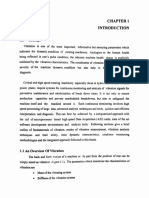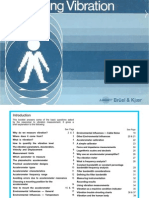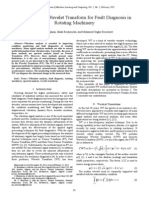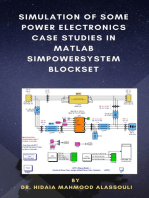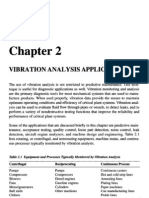Vibration Analysis Overview
Vibration Analysis Overview
Uploaded by
Vasile RaduCopyright:
Available Formats
Vibration Analysis Overview
Vibration Analysis Overview
Uploaded by
Vasile RaduOriginal Title
Copyright
Available Formats
Share this document
Did you find this document useful?
Is this content inappropriate?
Copyright:
Available Formats
Vibration Analysis Overview
Vibration Analysis Overview
Uploaded by
Vasile RaduCopyright:
Available Formats
Chapter 3
VIBRATION ANALYSIS OVERVIEW
Vibration theory and vibration profile, or signature, analyses are complex subjects that are the topic of many textbooks. The purpose of this chapter is to provide enough theory to allow the concept of vibration profiles and their analyses to be understood before beginning the more in-depth discussions in the later sections of this module.
THEORETICAL VIBRATION PROFILES
A vibration is a periodic motion or one that repeats itself after a certain interval of time. This time interval is referred to as the period of the vibration, T. A plot, or profile, of a vibration is shown in Figure 3.1, which shows the period, T, and the maxi1 mum displacement or amplitude, X,. The inverse of the period, - is called the T frequency, A of the vibration, which can be expressed in units of cycles per second (cps) or Hertz (Hz). A harmonic function is the simplest type of periodic motion and is shown in Figure 3.2, which is the harmonic function for the small oscillations of a simple pendulum. Such a relationship can be expressed by the equation:
X = X, sin(ot)
where
X = Vibration displacement (thousandths of an inch, or mils) X, = Maximum displacement or amplitude (mils) o = Circular frequency (radians per second)
t
= Time (seconds).
Vibration Analysis Overview
X
-eJ
t W
Q cn .-
0 0
fi
Figure 3.1 Periodic motionfor bearing pedestal of a steam turbine.
f Figure 3.2 Small oscillations o a simple pendulum, harmonicfunction.
Vibration Fundamentals
ACTUAL VIBRATION PROFILES
The process of vibration analysis requires the gathering of complex machine data, which must then be deciphered. As opposed to the simple theoretical vibration curves shown in Figures 3.1 and 3.2 above, the profile for a piece of equipment is extremely complex. This is true because there are usually many sources of vibration. Each source generates its own curve, but these are essentially added and displayed as a composite profile. These profiles can be displayed in two formats: time domain and frequency domain.
Time Domain
Vibration data plotted as amplitude versus time is referred to as a time-domain data profile. Some simple examples are shown in Figures 3.1 and 3.2. An example of the complexity of these type of data for an actual piece of industrial machinery is shown in Figure 3.3. Time-domain plots must be used for all linear and reciprocating motion machinery. They are useful in the overall analysis of machine-trains to study changes in operating conditions. However, time-domain data are difficult to use. Because all of the vibration data in this type of plot are added to represent the total displacement at any given time, it is difficult to determine the contribution of any particular vibration source. The French physicist and mathematician Jean Fourier determined that nonharmonic data functions such as the time-domain vibration profile are the mathematical sum of
3.00
- .00
h .
6-3.00 E 3. 3.00
.P
.00
-3.00I
0.01
0.02
Time (Sec)
0.03
0.04
0.05
Figure 3.3 Example o a typicaltime-domain vibmtion profile for apiece o machinery. f f
Vibration Analysis Overview
Figure 3.4 Discrete (harmonic)and total (nonharmonic)time-domain vibration curves.
simple harmonic functions. The dashed-line curves in Figure 3.4 represent discrete harmonic components of the total, or summed, nonharmonic curve represented by the solid line. These type of data, which are routinely taken during the life of a machine, are directly comparable to historical data taken at exactly the same running speed and load. However, this is not practical because of variations in day-to-day plant operations and changes in running speed. This significantly affects the profile and makes it impossible to compare historical data.
Frequency Domain
From a practical standpoint, simple harmonic vibration functions are related to the circular frequencies of the rotating or moving components. Therefore, these frequencies are some multiple of the basic running speed of the machine-train, which is expressed in revolutions per minute (rpm) or cycles per minute (cpm). Determining
10
Vibration Fundamentals
OS&NJi80
L!%
:XI3
50
100
150 200 FREQUENCY IN Hi!
250
300
xi0
Figure 3.5 Typicalfrequency-domain vibration signature.
these frequencies is the first basic step in analyzing the operating condition of the machine-train. Frequency-domain data are obtained by converting time-domain data using a mathematical technique referred to as a fast Fourier transform (FIT). FFT allows each vibration component of a complex machine-train spectrum to be shown as a discrete frequency peak. The frequency-domain amplitude can be the displacement per unit time related to a particular frequency, which is plotted as the Y-axis against frequency as the X-axis. This is opposed to the time-domain spectrum, which sums the velocities of all frequencies and plots the sum as the Y-axis against time as the X-axis. An example of a frequency-domain plot or vibration signature is shown in Figure 3.5. Frequency-domain data are required for equipment operating at more than one running speed and all rotating applications. Because the X-axis of the spectrum is frequency normalized to the running speed, a change in running speed will not affect the plot. A vibration component that is present at one running speed will still be found in the same location on the plot for another running speed after the normalization, although the amplitude may be different.
Vibration Analysis Overview hterprefation of Vibration Data
11
The key to using vibration signature analysis for predictive maintenance, diagnostic, and other applications is the ability to differentiate between normal and abnormal vibration profiles. Many vibrations are normal for a piece of rotating or moving machinery. Examples of these are normal rotations of shafts and other rotors, contact with bearings, gear-mesh, etc. However, specific problems with machinery generate abnormal, yet identifiable, vibrations. Examples of these are loose bolts, misaligned shafts, worn bearings, leaks, and incipient metal fatigue. Predictive maintenance utilizing vibration signature analysis is based on the following facts, which form the basis for the methods used to identify and quantify the root causes of failure: 1. All common machinery problems and failure modes have distinct vibration frequency components that can be isolated and identified. 2. A frequency-domain vibration signature is generally used for the analysis because it is comprised of discrete peaks, each representing a specific vibration source. 3. There is a cause, referred to as a forcing function, for every frequency component in a machine-trains vibration signature. 4. When the signature of a machine is compared over time, it will repeat until some event changes the vibration pattern (i.e., the amplitude of each distinct vibration component will remain constant until there is a change in the operating dynamics of the machine-train). While an increase or a decrease in amplitude may indicate degradation of the machine-train, this is not always the case. Variations in load, operating practices, and a variety of other normal changes also generate a change in the amplitude of one or more frequency components within the vibration signature. In addition, it is important to note that a lower amplitude does not necessarily indicate an improvement in the mechanical condition of the machine-train. Therefore, it is important that the source of all amplitude variations be clearly understood.
VIBRATION MEASURING EQUIPMENT
Vibration data are obtained by the following procedure: (1) Mount a transducer onto the machinery at various locations, typically machine housing and bearing caps, and (2) use a portable data-gathering device, referred to as a vibration monitor or analyzer, to connect to the transducer to obtain vibration readings.
Transducer
The transducer most commonly used to obtain vibration measurements is an accelerometer. It incorporates piezoelectric (i.e., pressure-sensitive) films to convert mechanical energy into electrical signals. The device generally incorporates a weight
12
Vibration Fundamentals
suspended between two piezoelectric films. The weight moves in response to vibration and squeezes the piezoelectric films, which sends an electrical signal each time the weight squeezes it.
Portable VibrationAnalyzer
The portable vibration analyzer incorporates a microprocessor that allows it to convert the electrical signal mathematically to acceleration per unit time, perform a FFT, and store the data. It can be programmed to generate alarms and displays of the data. The data stored by the analyzer can be downloaded to a personal or a more powerful computer to perform more sophisticated analyses, data storage and retrieval, and report generation.
You might also like
- Vivas For The Oral and Maxillofacial Surgery FRCS-WDocument241 pagesVivas For The Oral and Maxillofacial Surgery FRCS-Warisnicole588% (8)
- Machinery Diagnostic PlotsDocument16 pagesMachinery Diagnostic Plotsfazzlie100% (2)
- 1 ACC 2234 Hand-In Assignment 1 v2 2019Document4 pages1 ACC 2234 Hand-In Assignment 1 v2 2019Sameer Shabbir0% (2)
- Vibration Data and Formats: TypesDocument7 pagesVibration Data and Formats: TypesVasile RaduNo ratings yet
- Vibration Analysis and Signal Processing in LabVIEWDocument12 pagesVibration Analysis and Signal Processing in LabVIEWJam Bab100% (1)
- Pedotti2016 PDFDocument6 pagesPedotti2016 PDFbekhouche nasreddineNo ratings yet
- Vibration Application DataDocument44 pagesVibration Application DataSaurabh PanditNo ratings yet
- System1 Plots - Machinery-Diagnostic - Part1Document16 pagesSystem1 Plots - Machinery-Diagnostic - Part1Thyagaraju PalisettyNo ratings yet
- Vibration Prediction in Switched Reluctance Motors With Transfer Function Identification From Shaker and Force Hammer TestsDocument8 pagesVibration Prediction in Switched Reluctance Motors With Transfer Function Identification From Shaker and Force Hammer TestsKaran ShahNo ratings yet
- Modal Analysis and Condition MonitoringDocument5 pagesModal Analysis and Condition Monitoringbidyutkr30100% (2)
- Bruel & Kjaer TechnicalReview1987-1Document44 pagesBruel & Kjaer TechnicalReview1987-1Renzo ArangoNo ratings yet
- TOPIC 1: (Vibration Measurement) : Vibration Measurement, From The Word Itself Measures Vibration. "Vibration MeasurementDocument5 pagesTOPIC 1: (Vibration Measurement) : Vibration Measurement, From The Word Itself Measures Vibration. "Vibration MeasurementShanks XDNo ratings yet
- Vibration Measurement: Student Name: Salem Sobhy Student ID:20182734 Dr. Hassan Metered T.A: Eng. Osama AhmedDocument31 pagesVibration Measurement: Student Name: Salem Sobhy Student ID:20182734 Dr. Hassan Metered T.A: Eng. Osama AhmedSalem SobhyNo ratings yet
- Phasenoise HajimiriDocument16 pagesPhasenoise HajimiriMan Mohan GoelNo ratings yet
- Condition Monitoring Methods, Failure Identification and Analysis For Induction MachinesDocument8 pagesCondition Monitoring Methods, Failure Identification and Analysis For Induction MachinesRamya DeviNo ratings yet
- Study of Vibration - Power-MI: Aug 21, 2023 2:13 PMDocument13 pagesStudy of Vibration - Power-MI: Aug 21, 2023 2:13 PMabdalla AljzNo ratings yet
- CH 28Document6 pagesCH 28Vasile RaduNo ratings yet
- Vibration Theory: Periodic MotionDocument9 pagesVibration Theory: Periodic MotionVasile RaduNo ratings yet
- Identification of Torsional Vibration Features in Electrical Powered Rotating EquipmentDocument9 pagesIdentification of Torsional Vibration Features in Electrical Powered Rotating EquipmentHasan PashaNo ratings yet
- EM72 - 2007 Vibrations Article-Rene ArchambaultDocument4 pagesEM72 - 2007 Vibrations Article-Rene ArchambaultChad Hunt100% (1)
- Bo 0409Document8 pagesBo 0409eng13No ratings yet
- Vibration Measurement ProceduresDocument8 pagesVibration Measurement ProceduresEclipse Shu100% (1)
- Vibration Measurement ProceduresDocument8 pagesVibration Measurement ProceduresEclipse ShuNo ratings yet
- Gear Systems 2Document11 pagesGear Systems 2IAEME PublicationNo ratings yet
- Order Tracking AnalysisDocument51 pagesOrder Tracking AnalysisWon-young SeoNo ratings yet
- 1.0 Concept: Stiffness of The Vibration SystemDocument10 pages1.0 Concept: Stiffness of The Vibration SystemasprillaNo ratings yet
- Familiarization With and Performance Check Of, Vibration Testing & Measuring EquipmentDocument33 pagesFamiliarization With and Performance Check Of, Vibration Testing & Measuring EquipmentOmar Saleem100% (1)
- Diesel EngineDocument7 pagesDiesel EnginenaserNo ratings yet
- Motor Current Signature AnalysisDocument7 pagesMotor Current Signature AnalysisVinay Maithani CmrpNo ratings yet
- Wartsila Guideline Dynamics VibrationsDocument6 pagesWartsila Guideline Dynamics Vibrationsabm2281999No ratings yet
- EnvCepstrum Oct06Document11 pagesEnvCepstrum Oct06ridzim4638No ratings yet
- Engineering20100100006 78410574 PDFDocument9 pagesEngineering20100100006 78410574 PDFChintan RavalNo ratings yet
- Monitoreo ContinuoDocument9 pagesMonitoreo ContinuoCarlos Ernesto Flores AlbinoNo ratings yet
- Analysis of Dynamic Eccentricity Related Signatures On Stator Current of Squirrel Cage Induction MotorsDocument6 pagesAnalysis of Dynamic Eccentricity Related Signatures On Stator Current of Squirrel Cage Induction MotorsCarlos NúñezNo ratings yet
- Necessity of Vibration MeasurementDocument25 pagesNecessity of Vibration MeasurementRanjit Kadlag PatilNo ratings yet
- Data Acquisition: Detectors: TransducersDocument11 pagesData Acquisition: Detectors: TransducersVasile RaduNo ratings yet
- Chapter 4 Timebase Plots1Document18 pagesChapter 4 Timebase Plots1FabioRojasNo ratings yet
- CH5Document50 pagesCH5Adel Abdel-ghaffarNo ratings yet
- Vibration MeasurementDocument42 pagesVibration MeasurementChockkalingam Subramanian100% (2)
- Mechanic Experi̇mentsDocument26 pagesMechanic Experi̇mentsCANGONo ratings yet
- Troubleshooting Turbomachinery Using Startup and Coastdown Vibration DataDocument14 pagesTroubleshooting Turbomachinery Using Startup and Coastdown Vibration DataAhtsham AhmadNo ratings yet
- Vibration ISO Level 1 Module 2Document33 pagesVibration ISO Level 1 Module 2Shambhu Poddar100% (1)
- Condition Based Monitoring of Fan Using Vibration Analysis: Hemant Kumar, N. Tandon and S. FatimaDocument7 pagesCondition Based Monitoring of Fan Using Vibration Analysis: Hemant Kumar, N. Tandon and S. FatimaRiyaz RiyazNo ratings yet
- Measurement and Analysis of VibrationsDocument6 pagesMeasurement and Analysis of Vibrationsernestozag100% (1)
- Monitoring and Analysis of Machine VibrationDocument6 pagesMonitoring and Analysis of Machine VibrationAvinashNo ratings yet
- Basics of Vibration What Is Vibration (Fig. 2) ?Document8 pagesBasics of Vibration What Is Vibration (Fig. 2) ?nagarjuna reddy mNo ratings yet
- 142FFTDocument4 pages142FFTEduardo FerreiraNo ratings yet
- Signal Processing To Reduce The Effect of Gear DynamicsDocument7 pagesSignal Processing To Reduce The Effect of Gear DynamicsEric BechhoeferNo ratings yet
- Application of Wavelet Transform For Fault Diagnosis in Rotating MachineryDocument6 pagesApplication of Wavelet Transform For Fault Diagnosis in Rotating MachinerySaeed JavdaniNo ratings yet
- Using Time WaveformDocument5 pagesUsing Time WaveformfranksuaiNo ratings yet
- Vibration Prevention of Steam Turbine by Mixing The Main Demand With Vibration SignalDocument6 pagesVibration Prevention of Steam Turbine by Mixing The Main Demand With Vibration SignalInternational Journal of Application or Innovation in Engineering & ManagementNo ratings yet
- Vibrations of Power Plant Machines: A Guide for Recognition of Problems and TroubleshootingFrom EverandVibrations of Power Plant Machines: A Guide for Recognition of Problems and TroubleshootingNo ratings yet
- Analysis and Design of Multicell DC/DC Converters Using Vectorized ModelsFrom EverandAnalysis and Design of Multicell DC/DC Converters Using Vectorized ModelsNo ratings yet
- Analog Dialogue, Volume 48, Number 1: Analog Dialogue, #13From EverandAnalog Dialogue, Volume 48, Number 1: Analog Dialogue, #13Rating: 4 out of 5 stars4/5 (1)
- Electrical Machines: Lecture Notes for Electrical Machines CourseFrom EverandElectrical Machines: Lecture Notes for Electrical Machines CourseNo ratings yet
- Simulation of Some Power Electronics Case Studies in Matlab Simpowersystem BlocksetFrom EverandSimulation of Some Power Electronics Case Studies in Matlab Simpowersystem BlocksetRating: 2 out of 5 stars2/5 (1)
- Simulation of Some Power Electronics Case Studies in Matlab Simpowersystem BlocksetFrom EverandSimulation of Some Power Electronics Case Studies in Matlab Simpowersystem BlocksetNo ratings yet
- Newnes Boston Oxford Auckland Johannesburg Melbourne New DelhiDocument3 pagesNewnes Boston Oxford Auckland Johannesburg Melbourne New DelhiVasile RaduNo ratings yet
- ContentsDocument2 pagesContentsVasile RaduNo ratings yet
- CH 28Document6 pagesCH 28Vasile RaduNo ratings yet
- CH 27Document4 pagesCH 27Vasile RaduNo ratings yet
- CH 20Document5 pagesCH 20Vasile RaduNo ratings yet
- Analysis Techniques: TrendingDocument5 pagesAnalysis Techniques: TrendingVasile RaduNo ratings yet
- CH 12Document15 pagesCH 12Vasile RaduNo ratings yet
- CH 10Document6 pagesCH 10Vasile RaduNo ratings yet
- Data Acquisition: Detectors: TransducersDocument11 pagesData Acquisition: Detectors: TransducersVasile RaduNo ratings yet
- Machine Dynamics: Mass, DampingDocument16 pagesMachine Dynamics: Mass, DampingVasile RaduNo ratings yet
- CH 4Document4 pagesCH 4Vasile RaduNo ratings yet
- Vibration Theory: Periodic MotionDocument9 pagesVibration Theory: Periodic MotionVasile RaduNo ratings yet
- Vibration Analysis Applications: 2.1 Equipment and Processes Typical0 Monitored by Viiration AnalysisDocument3 pagesVibration Analysis Applications: 2.1 Equipment and Processes Typical0 Monitored by Viiration AnalysisVasile RaduNo ratings yet
- CH 1Document2 pagesCH 1Vasile RaduNo ratings yet
- Material SelfDocument23 pagesMaterial SelfJinky CalupitNo ratings yet
- Assignment Table of Task SpecificationsDocument2 pagesAssignment Table of Task SpecificationsAriputhiran NarayananNo ratings yet
- Affiliate Marketing 101Document25 pagesAffiliate Marketing 101Rita AsimNo ratings yet
- TAD570-572VE: 5.13 Liter, In-Line 4 Cylinder - 105, 129 & 160 KW EU Stage IV / US EPA Tier 4 FinalDocument2 pagesTAD570-572VE: 5.13 Liter, In-Line 4 Cylinder - 105, 129 & 160 KW EU Stage IV / US EPA Tier 4 Finaltotoro2020202020No ratings yet
- English ResearchDocument20 pagesEnglish ResearchIñaki Zuriel ConstantinoNo ratings yet
- Marshall 4e PPT Ch02 ACCESSDocument44 pagesMarshall 4e PPT Ch02 ACCESSdeoriesglobalNo ratings yet
- Jacob Rothschild The New Republic La Neu RepubliqueDocument3 pagesJacob Rothschild The New Republic La Neu RepubliqueNeal Hill Compton100% (1)
- HIPAA Presentation English 08012016Document55 pagesHIPAA Presentation English 08012016Eric LopezNo ratings yet
- 12g Bios Tuning For Performance Power PDFDocument36 pages12g Bios Tuning For Performance Power PDFSandeep ChanduNo ratings yet
- Kumaravel's ResumeDocument3 pagesKumaravel's ResumeKumarNo ratings yet
- Infinera Mtera Universal Transport PlatformDocument2 pagesInfinera Mtera Universal Transport Platformrobert adamsNo ratings yet
- Ac2 10 MPCDocument37 pagesAc2 10 MPCRaja BalanNo ratings yet
- Location: Taman Lestari Putra, Bandar Putra PermaiDocument12 pagesLocation: Taman Lestari Putra, Bandar Putra PermaiisbolatiNo ratings yet
- Food Fraud Prevention Checklist - Food Surety LimitedDocument3 pagesFood Fraud Prevention Checklist - Food Surety LimitedJesús Oscar Viloria LamedaNo ratings yet
- Sea Bed Logging (SBL), A New Method For Remote and Direct Identification of Hydrocarbon Filled Layers in Deepwater AreasDocument9 pagesSea Bed Logging (SBL), A New Method For Remote and Direct Identification of Hydrocarbon Filled Layers in Deepwater AreasCarlos Rafael Lizarraga ArreolaNo ratings yet
- Basic Principles of Biofiltration and System Design PDFDocument18 pagesBasic Principles of Biofiltration and System Design PDFveliger2009No ratings yet
- Palanca vs. Smith, Bell & Co. and Boncan, G.R. No. L-3695Document1 pagePalanca vs. Smith, Bell & Co. and Boncan, G.R. No. L-3695Lei Jeus TaligatosNo ratings yet
- Up9000 ManualDocument33 pagesUp9000 Manualho-faNo ratings yet
- Project Stage - IDocument12 pagesProject Stage - IPranav DarakhNo ratings yet
- Synopsis Sale Promotion Ultratech CementDocument10 pagesSynopsis Sale Promotion Ultratech CementsunnyNo ratings yet
- Critical Analysis of Mental Health Care ActDocument11 pagesCritical Analysis of Mental Health Care ActDeepshikha UghadeNo ratings yet
- AMCIN Individual FormDocument2 pagesAMCIN Individual FormSolomon PeterNo ratings yet
- HSC Board Practical Examination 2023-2024 Stream - CommerceDocument6 pagesHSC Board Practical Examination 2023-2024 Stream - CommerceshaistaNo ratings yet
- 48 Garcia v. Robles Vda. de CaparasDocument3 pages48 Garcia v. Robles Vda. de CaparasKatrina Janine Cabanos-ArceloNo ratings yet
- ASI Elec MotorsGenDocument7 pagesASI Elec MotorsGensdsfgeNo ratings yet
- ETHOS EASY-brochureDocument8 pagesETHOS EASY-brochureMichael MichaelidesNo ratings yet
- School of Cinematic Arts: SyllabusDocument8 pagesSchool of Cinematic Arts: SyllabusnnnnnatNo ratings yet
- Introduction To Herbalife Nutrition CompanyDocument2 pagesIntroduction To Herbalife Nutrition CompanyHuyền TrangNo ratings yet


























